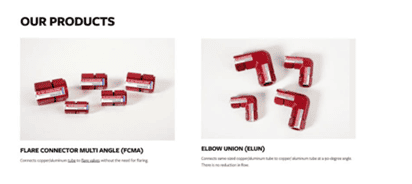Recently, the Trademark Trial and Appeal Board (the “TTAB”) affirmed the decision to cancel Registration Nos. 5,376,467 and 5,376,466, for the marks SMARTLOCK and SMARTLOCK with design (the “Smartlock Marks”), in the name of Locus Link USA.
The SMARTLOCK registrations were cancelled, as a result of the goods listed in the registrations inaccurately describing goods offered under the Smartlock Marks. 1
The Registrant sells refrigerant fittings used to connect air conditioning and cooling unit piping, but registered the Smartlock Marks in connection with: “[c]omponents for air conditioning and cooling systems, namely, evaporative air coolers,” in International Class 11. 2
Registrant’s Goods:

In Expungement Nos. 2022-100137E and 2022-100138E, the Examining Attorney cancelled the SMARTLOCK registrations given that the marks were actually used in connection with components of evaporative air coolers. The marks were not used in connection with the evaporative air coolers. 3 In fact, both the Registrant and Examining Attorney agreed that the goods sold under the Smartlock Marks were not used in connection with finished goods. 4
Ultimately, the TTAB decided that the Registrant did not accurately describe the goods it sells in its registrations under the Smartlock Marks. The TTAB focused on Registrant’s confused use of the term ‘namely’ in its description. The TTAB held that “‘namely’ …is acceptable only if the words that follow it define and fall within the scope of the introductory wording that precedes ‘namely’…” 5 Registrant described goods it does not sell after the term ‘namely’. Accordingly, it would have been appropriate if Registrant further delineated the types of components sold under its mark after the term ‘namely’.
It should be noted that the decision does not conflict with the standing rule. In fact, the Trademark Manual of Examining Procedure (“TMEP”) codifies exactly how applications for components should be identified:
When a mark is used to identify only a component or ingredient of a product, and not the entire product, the identification must (1) precisely set forth the common name of the component or ingredient, (2) indicate that the component or ingredient is sold as a component or ingredient of another finished product, and (3) set forth the common name of the finished product of which the identified component or ingredient forms a part. 6
Here, the identification left “doubt that the mark refers only to the component…and not to the entire product” 7despite Registrant’s argument that the description should be read as confined to components of a finished product.
Additionally, Registrant could have easily and accurately described its goods using alternate identification.
While the decision in In re Locus Link USA predominantly pertains to accurately describing the goods and services offered under a mark, the TTAB also emphasized the importance of using plain English to describe goods and services. Ultimately, “[t]he purpose of the identification of goods is to provide an understandable description of the goods, which an applicant accomplishes using the common commercial name for the goods.” 8
In addition to the trademark office preferring common names and terms, there are also cases which support applicants using terms of art to properly describe goods and services. For example, in In re Thor Tech, Inc., the term “park trailer” was deemed sufficiently narrow and definite, because park trailer is understood in its industry to mean something specific. 9 There, the Examiner was concerned that a park trailer would encompass mobile homes which the Applicant did not sell. 10 The TTAB reversed the Examiner’s decision finding that the term used was understood in the recreational vehicle space to connote a specific type of recreational vehicle and not a mobile home. 11 Simple and descriptive words are preferred, however, Applicants should not refrain from using terms of art common to the industry the goods and services are offered in.
Foreign trademark owners often use long descriptions of goods and services in trademark and service mark applications (when designating and/or applying for protection in the US) and often list components of finished offerings within the descriptions. In re Locus Link USA highlights the need to describe components and/or finished products correctly and clearly, and that an inaccurate description can invalidate a registration. Further, foreign applicants should consider using plain English and terms of art at the outset of the US trademark application process. Note that the USPTO requires a home jurisdiction right covering the applied for goods and services (in the US), but a US application can add specificity and be narrower than its home country basis.
It is always a safe strategy to defer to the Acceptable Identifications of Goods and Services Manual when crafting descriptions of goods and services for a US designation of an International Registration. 12
777 South Flagler Drive
Phillips Point East Tower, Suite 1000
West Palm Beach, FL 33401